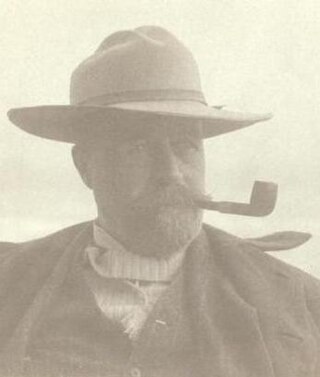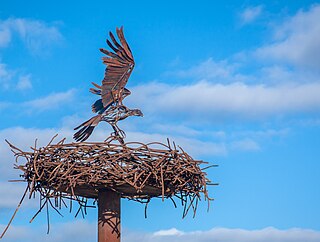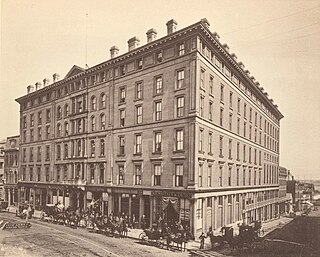Related Research Articles

Falmouth is a town in Cumberland County, Maine, United States. The population was 12,444 at the 2020 census. It is part of the Portland–South Portland–Biddeford, Maine metropolitan statistical area.

Casco Bay is an inlet of the Gulf of Maine on the coast of Maine in the United States. The National Oceanic and Atmospheric Administration's chart for Casco Bay marks the dividing line between the bay and the Gulf of Maine as running from Bald Head on Cape Small in Phippsburg west-southwest to Dyer Point in Cape Elizabeth. The city of Portland and the Port of Portland are on Casco Bay's western edge.

WMPG is a community radio station broadcasting from Portland, Maine. It is located on Bedford Street at the University of Southern Maine Portland Campus. It is affiliated with the college, and a mix of USM students and volunteers from the greater Portland community produce all the music and local public affairs programs. It broadcasts 4.5 kilowatts on 90.9.

John Calvin Stevens was an American architect who worked in the Shingle Style, in which he was a major innovator, and the Colonial Revival style. He designed more than 1,000 buildings in the state of Maine.
John Anderson was an American politician from Maine. Anderson served as United States Representative from Maine from 1825 to 1833.
The Portland Library Society (1763–1826) or Portland Library was a subscription library in Portland, Maine. The library "was originally established in 1763. It was revived in 1786, and re-established in 1806." Samuel Freeman served as librarian ca.1785-1807; followed by Oliver Bray (ca.1812-1817). New members were elected. The annual fee for each member was "two dollars per year in 1784 and fifteen dollars by 1801."
The following is a timeline of the history of the city of Portland, Maine, USA.

The Maine Central Railroad Company main line extended from Portland, Maine, east to the Canada–US border with New Brunswick at the Saint Croix–Vanceboro Railway Bridge. It is the transportation artery linking Maine cities to the national railway network. Sections of the main line had been built by predecessor railroads consolidated as the Maine Central in 1862 and extended to the Canada–US border in 1882. Through the early 20th century, the main line was double track from South Portland to Royal Junction, where it split into a lower road through Brunswick and Augusta and a back road through Lewiston which converged at Waterville into single track to Bangor and points east. Westbound trains typically used the lower road with lighter grades, while eastbound trains of empty cars used the back road. This historical description does not include changes following purchase of the Maine Central Railroad by Guilford Transportation Industries in 1981 and subsequent operation as part of Pan Am Railways.

The Norton House Historic District encompasses two properties that formerly constituted the central portion of a suburban country estate in Falmouth, Maine. Located on Foreside Road, overlooking Casco Bay, the landscaped properties include a house and former carriage house designed by John Calvin Stevens and John Howard Stevens in 1912. The district was listed on the National Register of Historic Places in 2004.
The Governor Baxter School for the Deaf (GBSD), formerly known as the Maine School for the Deaf is a public co-educational school that serves the deaf and hard-of-hearing in the State of Maine. It is located on Mackworth Island, an approximately 100-acre (40 ha) island in Falmouth, Maine, USA, adjacent to its border with Portland, Maine. Students who live far away may stay with host families, who provide residential services. Its program is the Maine Educational Center for the Deaf and Hard of Hearing (MECDHH).
Samuel Jameson Anderson (1824-1905) was a businessperson, lawyer and politician from Maine. He also was president of the Portland-Ogdensburg Railroad. Anderson, a Democrat, represented Portland in the Maine House of Representatives in 1876.
Neal Woodside Allen (1885–1976) was an American politician and businessperson from Portland, Maine. He served as chairman of the Portland City Council twice (1925–26). He was elected to the first city council chosen in December 1923 after the Chamber of Commerce and Ku Klux Klan collaborated to install a council–manager government. In 1912, he purchased F. O. Bailey company, an auctioneering company which he held until his death. In 1942, he was one of the founding appointees to the Portland Planning Board and regularly served as its chair.

William McLellan was an American merchant sea captain. He was owner and master of the sloop Centurian, which was one of the vessels destroyed at the hands of the British during the Penobscot Expedition in 1779, part of the American Revolutionary War.

Martin's Point Bridge spans the Presumpscot River in Maine, United States, near the river’s mouth with Casco Bay. It connects Falmouth Foreside, at Mackworth Point, in the north, to the East Deering neighborhood of Portland, at Martin's Point, in the south. 1,300 feet (400 m) in length, it carries vehicular and pedestrian traffic of U.S. Route 1. The bridge is two lanes, including a bicycle lane in each, with a pedestrian lane on the eastern side. A similar plan for the western side of the bridge was abandoned.

Portland and Yarmouth Electric Railway was an electric trolleycar service that ran along the coast between Portland and Yarmouth, Maine, from 1898 and 1933. Described in 1901 as the "new electric road", Yarmouth was "now a closer neighbor [to Portland] than ever before" because of the railway's advent.

Underwood Spring Park was a 19th- and 20th-century pleasure resort overlooking Casco Bay in Falmouth Foreside, Maine, United States. Containing an open-air theater, a casino and a gazebo, it was a popular gathering spot serviced by the trolley cars of the Portland and Yarmouth Electric Railway. The Portland and Yarmouth Electric Railway Company opened the park, located to north of the town landing, on July 18, 1899, to promote the line's service to and from Portland, Maine's largest city, every fifteen minutes. A looped spur off the main line was built the month following the resort's completion to facilitate the ease of passengers' arrivals.
George Burnham was an American architect from Portland, Maine. He was active in the second half of the 20th century and first half of the 21st century.

Middle Street is a downtown street in Portland, Maine, United States. Dating to 1724, it runs for around 0.46 miles (0.74 km), from an intersection with Union Street, Spring Street and Temple Street in the southwest, to Hancock Street, at the foot of Munjoy Hill, in the northeast. It formerly originated at what was then known as Market Square, but 20th-century redevelopment saw the section between Monument Square and Free Street pedestrianized, and the remaining section—around The Maine Lobsterman monument on Temple Street—erased.

The Falmouth Hotel was a six-story, 240-room hotel in Portland, Maine. It stood on Middle Street, between a now-demolished Plum Street and the extant Union Street, from 1868 to 1963, when it was torn down for being a fire hazard. Presidents Ulysses S. Grant, William McKinley, Theodore Roosevelt, William Howard Taft and Warren G. Harding all stayed at the hotel, while United States Army General William Sherman visited the hotel in 1898. Due to its regular hosting of functions, the hotel became known as the "hotel of a million banquets." Plum Street connected Fore Street and Middle Street between Exchange Street and Union Street.
References
- ↑ "Portland Yacht Club, Merchant's Wharf, ca. 1910". Maine Memory Network.
- ↑ "Portland Yacht Club, ca. 1900". Maine Memory Network.
- ↑ The Portland Yacht Club, 1869-1963. 1963.